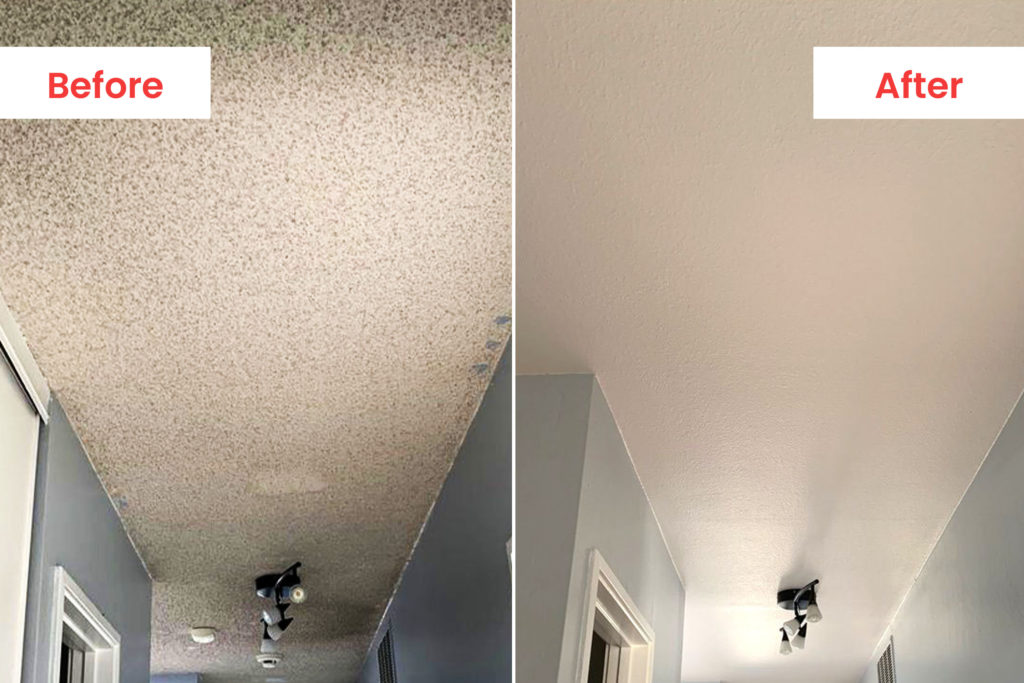
Popcorn ceilings were once a common feature in American homes, especially between the 1950s and the 1980s. Their textured appearance provided a quick, inexpensive way to conceal imperfections while also improving sound absorption. However, many of these ceilings were created using materials that contained asbestos, a naturally occurring mineral linked to serious health risks. For homeowners in Tampa considering ceiling repair or renovation, understanding the potential presence of asbestos is a necessary step before any removal or disturbance begins.
Understanding What Asbestos Is
Asbestos refers to a group of fibrous minerals that were widely used in building materials for their durability, resistance to fire, and ability to insulate. During the height of its popularity, it was mixed into joint compounds, spray coatings, and textured ceiling finishes such as popcorn ceilings. When left undisturbed, asbestos may not pose an immediate threat. The danger arises when fibers become airborne through scraping, sanding, or drilling. Once inhaled, these microscopic fibers can lodge in lung tissue, leading to diseases such as mesothelioma, asbestosis, or lung cancer.
Why Popcorn Ceilings Often Contain Asbestos
Before federal regulations restricted asbestos use in the late 1970s, many popcorn ceiling materials contained it as a binding and texturizing agent. Contractors used asbestos to strengthen ceiling coatings and make them easier to apply. Homes built or renovated before 1980 are more likely to contain this type of material, although some suppliers continued to use existing stock even into the early 1990s.
For homeowners in Tampa, where many houses were constructed during this period, the likelihood of asbestos presence cannot be dismissed without proper testing. Visual inspection alone is not sufficient, as asbestos fibers are invisible to the naked eye.
The Risk of DIY Removal
Removing a popcorn ceiling without testing it first can lead to serious health hazards. Scraping or sanding releases asbestos fibers into the air, where they can circulate and settle on furniture, carpets, and HVAC systems. Even small amounts of exposure can have long-term health consequences.
A common mistake among homeowners is assuming that sealing the area with plastic or wearing a mask provides adequate protection. Standard household masks do not filter asbestos fibers effectively, and ordinary vacuums can spread contamination instead of removing it. Professional containment methods and specialized equipment are required to handle asbestos safely.
Testing Before Any Work Begins
Before starting any ceiling repair or remodeling project, testing for asbestos is a critical first step. Certified environmental specialists or licensed asbestos inspectors can collect samples from the ceiling material and have them analyzed in a laboratory. The testing process is quick, and results provide definitive guidance on how to proceed.
Homeowners should avoid direct contact with the affected material if they detect asbestos. Professional abatement companies are trained to follow federal and state safety standards, using specialized protective gear and filtration systems to prevent contamination. In Tampa and across Florida, these procedures are strictly regulated to protect both residents and contractors.
Professional Removal and Encapsulation Options
If your popcorn ceiling tests positive for asbestos, professional removal is not your only option. In some cases, encapsulation provides a safer and more cost-effective solution. This involves sealing the asbestos material beneath a layer of paint or a new ceiling covering, such as drywall or paneling. Encapsulation prevents fibers from becoming airborne while maintaining structural stability.
However, if the ceiling is damaged, crumbling, or scheduled for major renovation, complete removal may be the best choice. Licensed contractors use specialized tools to keep the material wet during removal, reducing airborne dust. They then dispose of contaminated materials according to environmental regulations. The process concludes with air testing to ensure the area is safe for reentry.
Why Professional Expertise Matters
Handling asbestos is not a task for general contractors or untrained workers. Certified professionals understand how to manage air filtration, waste disposal, and post-removal cleaning. Attempting to save money through do-it-yourself removal often leads to higher costs in the long run if contamination occurs.
Homeowners should also be aware that selling or renting a property with known asbestos contamination may involve disclosure requirements. Addressing the issue properly protects both health and property value.
Final Thoughts
Popcorn ceilings may appear harmless, but when they contain asbestos, removal becomes a matter of health and safety rather than appearance. Homeowners in Tampa who are planning ceiling repair or renovation should begin with professional testing before disturbing any material. If specialists detect asbestos, they can safely remove it or encapsulate it to prevent contamination in your home.
Get expert ceiling services from Ceiling Solutions Fast, carried out with diligence and adherence to regulations. Their experienced team provides thorough inspection, repair, and ceiling restoration throughout the Tampa area, ensuring your home remains both attractive and safe for years to come.